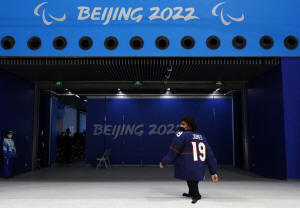Paralympics-Adaptive tools and techniques powering the 2022 Winter Games
 Send a link to a friend
Send a link to a friend
[March 12, 2022] By
Aditi Bhandari
 (Reuters) - Open to athletes with
disabilities in their vision, limbs and body, including muscle,
control and coordination issues, the Winter Paralympic Games have
grown over the years to include more sports and disability types. (Reuters) - Open to athletes with
disabilities in their vision, limbs and body, including muscle,
control and coordination issues, the Winter Paralympic Games have
grown over the years to include more sports and disability types.
More sports means more kinds of equipment built from scratch to suit
athletes' abilities.
"Without adaptive tools we wouldn't be able to perform the way we
do," said three-time Paralympic snowboarder Mike Schultz. "In some
cases that tool or that adaptive device is the difference in
performance from one athlete to another."
According to the International Paralympic Committee's (IPC)
guidelines, adaptive sports equipment must be safe to use, regulated
by the sport's rules and can't artificially enhance an athlete's
performance.

They should also be commercially available to any athlete, rather
than bespoke tools made for a select few. Athletes register their
equipment for approval with the IPC months in advance of competing.
Adaptive athletes like Schultz and three-time Paralympic
snowboarding medallist Amy Purdy even end up designing and building
their own prosthetics in order to compete.
[to top of second column] |

Beijing 2022 Winter Paralympic Games - Para Ice Hockey - Semi Final
2 - United States v China - National Indoor Stadium, Beijing, China
- March 11, 2022. Malik Jones of the United States after the match.
REUTERS/Peter Cziborra

"I ended up customising my feet and my board
together, where I would narrow the board, and then I would get
bigger feet," said Purdy, who had a double below-knee amputation at
19 after developing sepsis due to meningitis.
The Winter Paralympics are both a platform for athletic prowess and
a testament to innovative adaptive engineering and design.
"As Paralympic athletes, we are athletes first," Schultz said. "We
work just as hard, or in some cases harder, than able-bodied
athletes."
"The difference is that we have to use tools to bridge the gap of
what's physically possible or not possible because of our
disability."
(Reporting by Aditi Bhandari; Editing by Tom Hogue and Karishma
Singh)
[© 2022 Thomson Reuters. All rights
reserved.] This material may not be published,
broadcast, rewritten or redistributed.
Thompson Reuters is solely responsible for this content.
 |